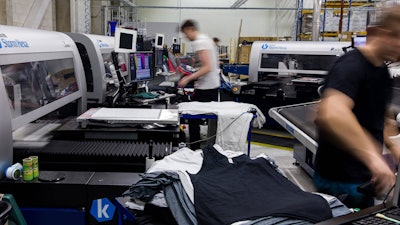
For the past decade, global supply chains have been running a seemingly normal path. However, when COVID hit its peak in March 2020, it exposed many of the vulnerabilities that have been affecting these networks. Even a year and half later, industries across the board are experiencing the impacts of supply chain disruptions. With massive labor shortages and continual shipping delays, there is an increasing desperation to return “back to normal.” Instead of quickly returning back to the way things used to be, we should examine the root causes of these issues and create a new model that better aligns with the world we live in today.
Currently, the majority of global supply chains operate on a global warehousing method due to the industry standard of bulk production from a single manufacturer. Typically, bulk orders are routed from one vendor to another distribution center across the globe. While this system can provide some economies of scale, it has also led to wasteful overproduction, increased pollution, inflexible startup costs and major supply chain disruptions.
Industry leaders, brands, and retailers should instead consider incorporating smarter supply chains that uniquely combine technology, data, and manufacturing to automate and optimize the flow of production, procurement, and logistics.
Because consumers can order around the clock, forecasting demand is less predictable, the volume of order sizes lowers, and the number of products offered increases. Coupled with consumer expectations of short delivery times and high customer satisfaction, businesses need to ensure their supply chain requirements can deliver on speed, complexity, and efficiency. A smarter supply chain can meet and even exceed these seemingly impossible expectations.
Smart Supply Chain: On-Demand Manufacturing + Global Production Network
The manufacturing portion of a smart supply chain unites on-demand manufacturing, a process where goods are created only when needed and in the quantities required, with global production, a distributed network that transfers raw materials to production facilities closest to end consumers for final assembly.
On-demand manufacturing and global production are not only more sustainable than traditional manufacturing methods, they also allow for more flexibility, efficiency, and responsiveness when issues arise such as the current global shortages and delays.
Moving from Global Warehousing to Global Production
Global warehousing, or traditional wholesale manufacturing, relies on storing items until they are ready to be shipped. Many retailers and businesses have historically depended on this method given there were no other reasonable alternatives for decades. Technological advancements have not only paved the way for new more affordable options but have brought to light the many disadvantages of global warehousing including, but not limited to:
- Producing excess inventory
- Inflexible to changing consumer preferences
- Leading to disengaged workforce
- Requiring high start up costs
The inflexibility and costly nature of global warehousing are two of the major reasons why global supply chains have been struggling to keep up with unprecedented demand.
Use Cases of On-Demand Manufacturing + Global Production
While both on-demand and global production are relatively new processes within the past decade, remnants of each model have been proven across multiple industries.
- The automotive industry embraces a similar just-in-time approach with their parts and assembly. Instead of selling their vehicles at traditional dealerships, Tesla uses stores that are usually found at popular shopping centers. Customers can’t simply drive away with a Tesla either, they can view sample vehicles and then order a customized car online with the help of a sales expert. That level of personalization and detail can only be achieved via an on-demand production model, which Tesla and other European automotive brands successfully utilize.
- Ecommerce businesses that implement a print on demand model also only produce items until a customer places an order, eliminating the need for wasteful inventory and costly order minimums. Additionally, this on-demand method helps shrink the supply chain—meaning, the time it takes to produce and ship an item—from 30 and 45 days to between two and three days. Lowering the restock supply chain lead time allows brands to significantly cut down on the initial inventory runs which in turn helps them be more reactive to customer preferences that dictate the winners and the losers within a design, a SKU, a model, or a season.
- Similar to the distributed network in the global production model, Akamai paved the way in the computer network industry by eliminating network hops and putting servers closer to the end user in order to quickly and more efficiently deliver content. Akamai’s platform has greatly improved Internet latency and exemplifies how a distributed architecture can yield more flexibility and responsiveness. Gooten, a smart supply chain provider, has a parallel approach in the manufacturing space where they utilize a distributed network of global manufacturers to fulfill on-demand orders more efficiently, sustainability, and at a competitive rate. What’s more, Gooten produces 70% of its orders in the U.S. at 23 factories spanning from New Jersey to Oregon.
Embracing a Smarter Supply Chain
With all the benefits that on-demand and global production provide, it’s easy to wonder why more businesses aren’t embracing them. Despite major outlets such as Vogue and Amazon creating buzz around on-demand manufacturing as an answer to many of the supply chain industry’s biggest challenges, it has made headway primarily amongst startups and eCommerce brands. The major impediment for embracing on-demand is primarily due to knowledge gaps and general resistance to change.
Whenever there are revolutionary shifts in any industry, there are always old guards that are comfortable with the existing status quo. One of the more notable examples of this is the film industry shifting from film cinema cameras to digital recording technologies. While the advantages of digital are paramount—from cost savings, ease of use, flexibility, and accessibility—it took over a decade for the industry to fully adopt the method. Hollywood began filming digitally in the 2000s but it wasn’t until 2013 that digitally shot films began the norm amongst the top 100 grossing films.
While they are not mutually exclusive, one can argue that the supply chain disruptions have a far greater impact than the use of digital over film. That’s why it is imperative for companies to embrace the change, even partially, from global warehousing to global production in order to overcome supply chain disruptions and sustain themselves for years to come.
Mark Kapczynski is the Chief Marketing Officer of Gooten, a globally distributed company that operates a smart supply chain for brands and retailers that are looking to utilize print on-demand manufacturing to transform the way they do business.























